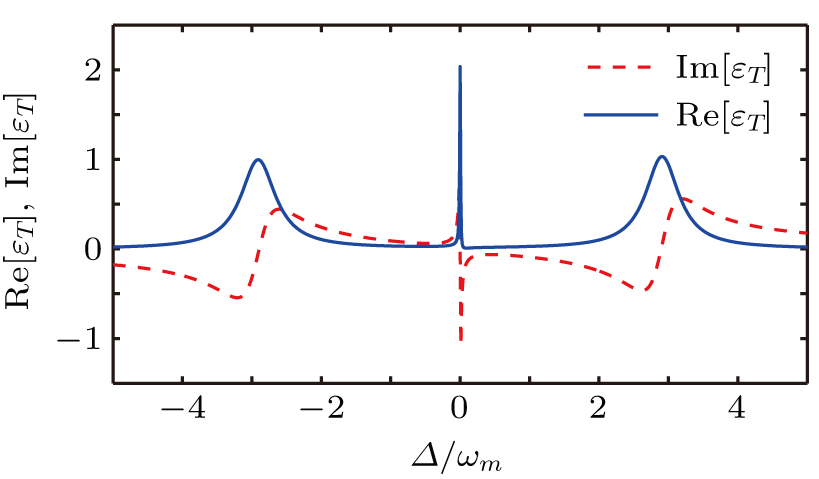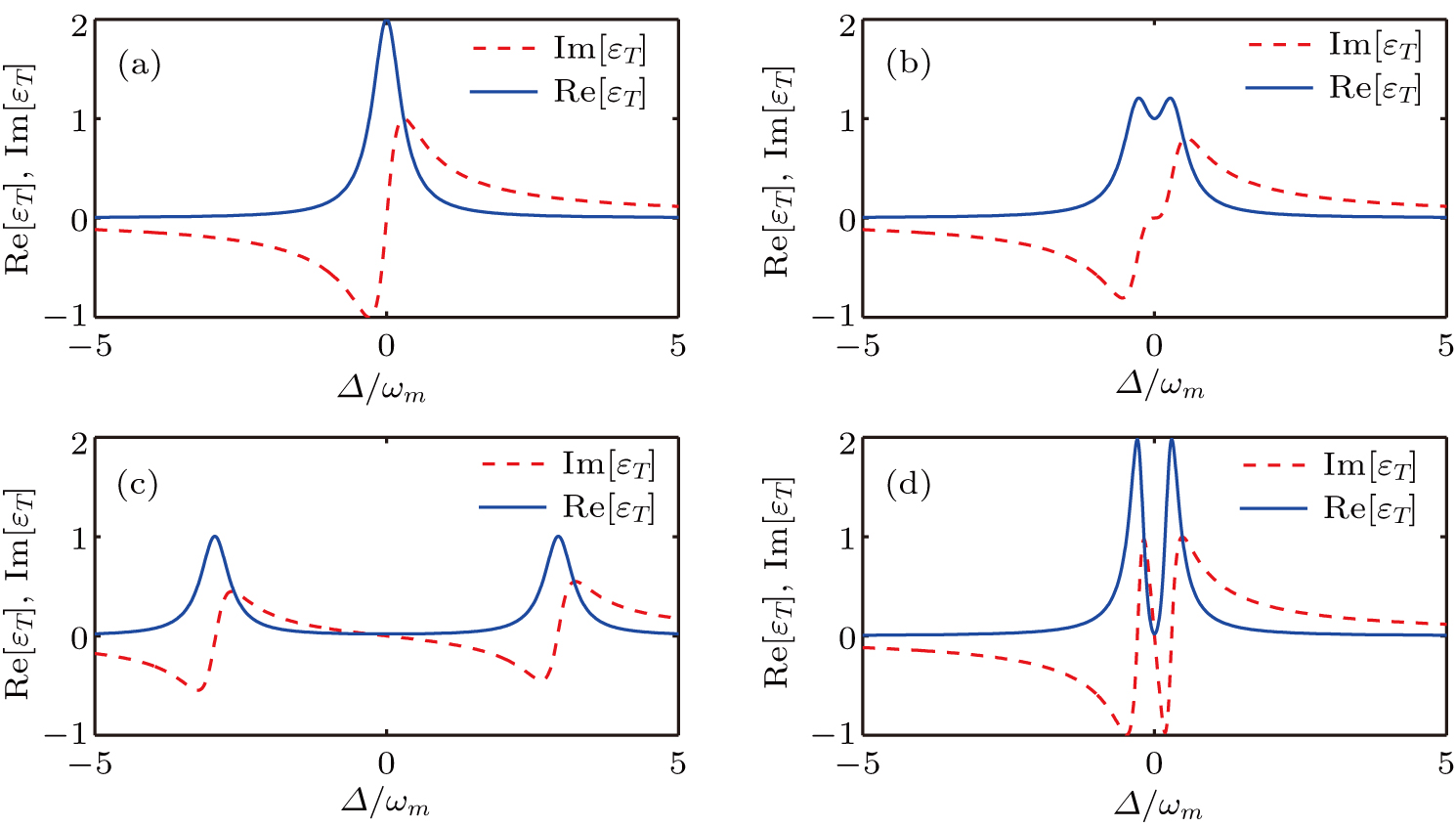† Corresponding author. E-mail:
We study opto-electromechanically induced transparency in a hybrid opto-electromechanical system made up of an optical cavity tunneling-coupled to an opto-mechanical cavity, which is capacitively coupled to a charged mechanical oscillator by a charged and moveable mechanical cavity mirror as an interface. By studying the effects of the different parameters on the output field, we propose a scheme to modulate the opto-electromechanically induced transparency (OEMIT). Our results show that the OEMIT with the transparency windows from single to double to triple can be modulated by changing the tunneling, opto-mechanical and electrical couplings. In addition, the explanation of the OEMIT with multi-windows is given by the energy level diagram based on quantum interference. Our investigation will provide an optimal platform to manipulate the transmission of optical field via microfabricated opto-electromechanical device.
Over the past two decades cavity quantum electrodynamics (QED) has the blooming developments and become one of the most promising setups to investigate the interactions between light and matter at the quantum level.[1, 2] The progress has shown that cavity QED offers an interesting tool to implement quantum manipulation technology. For example, cavity-induced transparency[3] is an electromagnetically induced transparency (EIT)-like effect.[4] The EIT-like effect provided large valuable contributions and important roles in a variety of quantum processes, such as nonlinear susceptibility modulation,[5] light switch,[6] quantum memory,[7] and quantum communication.[8]
As a novel extension of the cavity, cavity opto-mechanics system is usually composed of Fabry–Pérot (FP) cavity with one fixed mirror replaced by a mechanical oscillator as a movable mirror, where the optical field in the cavity can couple to the mechanical oscillator via the radiation pressure.[9] Recently such cavity opto-mechanics has become one of the most promising platform to study the interactions between optical and mechanical modes or between optical fields and atoms, and has attracted increasing interest in both theory and experiment.[9, 10] More importantly, some theories in QED can be further extended to the cavity opto-mechanics,[10] where many interesting phenomena and effects have been theoretically predicted then experimentally demonstrated, such as opto-mechanically induced transparency (OMIT, EIT-like),[11–13] frequency transfer,[14] and normal-mode splitting.[15] In addition, this system can be applied to studying the cooling of mechanical oscillator,[16, 17] precision measurement,[18–21] quantum information transfer,[22, 23] etc. When the combination of opto-mechanical system with atoms or the nitrogen–vacancy centers in various hybrid systems allows for light switch,[24] electro-optic waveform interconnect,[25] the strong coupling of the mechanical oscillations to the atomic spin[26] and phonon-induced spin–spin interactions.[27] Therefore cavity opto-mechanics system has shown significant advantages and may be applicable to future quantum networks.[10]
The transmission spectroscopy of the cavity is of crucial importance to control the propagation and absorption of optical field in practical application. Therefore, the output of cavity opto-mechanics is widely studied, especially the OMIT effect caused by the destructive interference.[28] However, the OMIT with a single transparency window in the frequency domain limits the manifold functionalities for nonlinear optics and optical communication.[10] In recent studies, the single-OMIT has been extended to the double transparency windows in the divers opto-mechanical modes. The double transparency can be induced by two charged nano-mechanical resonators with Coulomb interaction,[29] the coherent oscillations of the two mechanical oscillators,[30] two tunneling-coupled resonators,[31] two coupling opto-mechanical cavities,[32] and coupling the mechanical resonator to a two-level system.[33] Further, multiple-OMIT was also found in multiple-cavity opto-mechanical system coupled to one two-level atom.[34] It is worth noting that the multiple-OMIT in the nanostructure system can be applied in all-optical communication,[31] all optical quantum network, and multi-channel quantum information processing.[35] Therefore it is very valuable and significant to research the manipulation of the multiple-OMIT.
In order to break frequency limitation of the transparency window and realize multiple-channel optical communication,[10] this device should satisfy the following conditions: (i) the multiple transparent windows; (ii) controllable transparent windows; (iii) advantageous integrability on the chip. For this purpose we propose a scheme to manipulate the opto-electromechanically induced transparency (OEMIT) with multi-windows in a hybrid opto-electromechanical device consisted of two tunneling coupled cavities including one FP cavity and one opto-mechanical cavity. The charged mechanical mirror of the opto-mechanical cavity is capacitively coupled to another charged mechanical oscillator by the Coulomb interaction, i.e., a mechanically tunable capacitor. By combining the coherent cavity,[31] opto-mechanical,[11] and Coulomb couplings[29] into a micro-fabricated hybrid opto-electromechanical module, we successively show the single, double, and triple transparency windows, i.e., a controllable multiple-OMIT, whose width can be adjusted by changing the parameters of the system. Here the transparency is a hybrid opto-electromechanically induced transparency. This integrated device including functions of three of induced transparency will excite a development trend and implementation prospect towards the integration quantum module device.
The paper is organized as follows. In Section 2, we introduce the hybrid opto-electromechanical model and theoretical equations. We will discuss OEMIT in our system and propose a scheme to modulate the transparency windows of OEMIT in Section 3. Finally we give the conclusion.
The hybrid opto-electromechanical system (HOEMS) under consideration is shown schematically in Fig. 








 |
 |
 |


















Considering the effects of noise terms on the cavity fields and NMOs, the Langevin equations of the HOEMS are given by the following expressions[37]
 |











 |

 |
 |

 |












 |


 |
In order to find the response of the system to the probe frequency, by the output field based on the input–output theory,[11, 31] we can obtain
 |

 |

Now we present the opto-electromechanically induced multi-transparency in the HOEMS and study the manipulation of OEMIT in the different cases. We find that the number and width of the OEMIT windows can be modulated and some interesting phenomena can be observed. Here we employ the parameters from the recent experiment,[12, 31] where the mass m = 20 ng, the frequency 




If the tunneling-coupling strength between two cavity fields J = 0, i.e., the system only includes an FP cavity driven by the pump and probe fields, Figure 


When the opto-mechanical coupling g is negligible with 
 |

Further considered the opto-mechanical coupling and ignoring the Coulomb coupling, the output field can be given by
 |


 | Fig. 3. The absorption Re 



|
Moreover, when the NMO 



In summary, we proposed a scheme to implement the manipulation of the opto-electromechanically induced transparency based on OMIT in a hybrid opto-electromechanical device composed of an FP cavity tunneling-coupled to a hybrid opto-electromechanical system. By studying the probe output field of the FP cavity, we found the OEMIT with the tunable multi-transparency windows. When the tunneling coupling is considered and the opto-mechanical coupling is negligible (g = 0) with the high quality opto-mechanical cavity 



| [1] | |
| [2] | |
| [3] | |
| [4] | |
| [5] | |
| [6] | |
| [7] | |
| [8] | |
| [9] | |
| [10] | |
| [11] | |
| [12] | |
| [13] | |
| [14] | |
| [15] | |
| [16] | |
| [17] | |
| [18] | |
| [19] | |
| [20] | |
| [21] | |
| [22] | |
| [23] | |
| [24] | |
| [25] | |
| [26] | |
| [27] | |
| [28] | |
| [29] | |
| [30] | |
| [31] | |
| [32] | |
| [33] | |
| [34] | |
| [35] | |
| [36] | |
| [37] | |
| [38] |






























